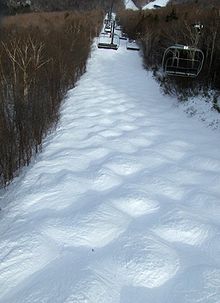Mogul slope
A mogul slope is an evenly uneven ski slope along its entire length . The bumps range from small hills (from about 30 centimeters) to bumps in the height of one meter and more.
A mogul slope can be created naturally or artificially. In many ski areas , certain slopes or individual slopes are not or only very rarely groomed (leveled, see ski slope ) in order to enable the creation of natural mogul slopes . Such routes are mostly marked as ski routes or black ski slopes . Furthermore, natural mogul slopes often arise in the more heavily trafficked areas to the left and right of marked ski slopes, for example through the breaking of deep snow . Artificially created mogul slopes are mainly used in freestyle competitive sports .
In English "Buckelpiste" means mogul piste - mogul (hump) comes from a German dialect (similar to the Viennese mugl : small hill) and has been known in English since 1959.
Technique of mogul skiing
The skiing in the moguls or in similar hilly ground , the technique requires the short swing with a high degree of predictive driving style and a sense of rhythm. The skier drives tightly parallel and swings close to the fall line around the hump, over the hump slopes or the hump tops. It is important to control the driving speed, keep the beat and look ahead to find a track through the hump. The upper body remains calmly in a central position while the legs are actively bent and stretched in order to always maintain snow contact with the ski. So that your legs have the necessary freedom of movement, you shouldn't (!) Bend your knees more strongly than on a level slope.
You can learn to ski moguls, for example, by swinging quickly on flat and then steep terrain, swinging with changing curve radii , swinging according to a given cycle and practicing a proactive driving style. Using sticks and the use of poles is essential in moguls. The active leg movements, the very short turns and the control of the skis require a considerable amount of effort, so that mastering the mogul slope places very high demands on the fitness of the driver.
Because of the tight, parallel skiing technique, narrow, less tapered skis are an advantage for moguls. This represents a certain contrast to the increasingly wider carving skis of the last few years. However, some manufacturers also offer ski models (English: Mogul skis ) that have been specially developed for mogul slopes and are mainly used in competition. However, they are very difficult to obtain in specialist shops.
Mogul skiing as a competition

Skiing on the moguls is a discipline of freestyle skiing . The athletes drive through an artificially created mogul slope, two jumps are required. There are points for the driving speed (25%), the technique used (50%) and for the execution of the jumps (25%). In the Parallel Moguls (English Dual Moguls) competition, two athletes ride the moguls head-to-head against each other.
As part of the Freestyle Skiing World Championships , world champions in the Moguls discipline have been determined since 1986 , and in the Dual Moguls since 1999 .
Driving on the moguls was a demonstration competition at the 1988 Winter Olympics in Calgary, since the 1992 Winter Olympics in Albertville, they have been a regular Olympic competition. The first Olympic champions were the French Edgar Grospiron in 1992 and the American Donna Weinbrecht , the most successful Olympic athlete is the Canadian Alexandre Bilodeau with two gold medals ( 2010 and 2014 ).
receipt
- ^ Mogul in the Lexicon Merriam-Webbster (accessed November 16, 2014)
Web links
- Technical model for mogul skiing by Thomas Ofner
- Skiing in the moguls: The most important tips for skiers on skiinfo.de, January 18, 2012
- Threatened mogul slopes: Adventure playgrounds in the Alps , article by Tim Tolsdorff in Spiegel Online , February 10, 2012
